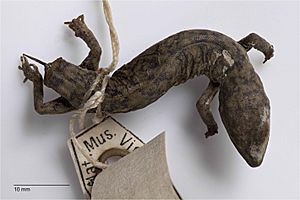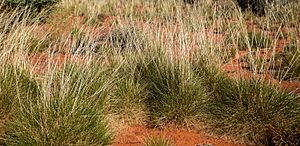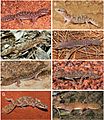Variable fat-tailed gecko facts for kids
Quick facts for kids Variable fat-tailed gecko |
|
|---|---|
 |
|
| Conservation status | |
| Scientific classification | |
| Genus: |
Diplodactylus
|
| Species: |
conspicillatus
|
The variable fat-tailed gecko (also called the burrow-plug gecko) is a special type of gecko. It lives only in the dry, central parts of Australia. These geckos are found in sandy deserts, especially where a spiky grass called Spinifex grows. People also keep them as pets or in zoos.
Contents
What Does It Look Like?
This gecko is a small to medium-sized lizard. Its body is usually light brown or reddish-brown. It has a dark brown net-like pattern on its back. You might also see pale or white spots all over its body. Its legs, lips, and belly are lighter in color. There's often a dark line from its nose to its eye, sometimes going past the eye.
Variable fat-tailed geckos have a strong body and short legs. Their tail is wide and flat, about the same size as their head. They are about 60 mm (2.4 inches) long from their nose to the end of their body. Their tail is about 24 mm (1 inch) long.
Like most geckos, they don't have eyelids that move. Instead, they use their long, flexible tongue to keep their eyes wet and clean. Both male and female geckos have small, spiky bumps near their tail, called paracloacal spurs. A key way to tell this gecko apart is that it does not have pre-anal pores.
Naming the Gecko
The variable fat-tailed gecko, Diplodactylus conspicillatus, was first named in 1897. This was done by two scientists, Arthur Henry Lucas and Charles Frost.
The group of geckos called Diplodactylus has 27 different species. They are often called stone geckos or fat-tailed geckos. Many species in this group look very similar. Because of this, scientists have sometimes changed how these geckos are named over the years. This helps them better understand the different types.
Where Does It Live?
The variable fat-tailed gecko lives all over mainland Australia. It prefers dry and semi-dry areas. You can find them in New South Wales, Queensland, South Australia, and northern parts of Western Australia and the Northern Territory. They also live near the coast in some northern areas.
These geckos live on the ground. They can be found in sandy deserts, open grasslands, and rocky areas. But they like sandy deserts with Spinifex grass the most. During the day, they often hide in fallen trees, cracks in the ground, under rocks, or in old burrows made by other lizards or spiders.
Daily Life of the Gecko
Variable fat-tailed geckos are nocturnal. This means they are active at night. Like most lizards, they are ectothermic. This means they get their body heat from outside sources, like the sun. They warm up during the day. This gives them energy to hunt and digest their food at night.
Since they are active at night, they need safe, warm places to hide during the day. They use rocks, fallen trees, and abandoned burrows. Hiding helps them stay safe from animals that hunt during the day. It also keeps their body temperature from getting too hot in the desert sun.
Not much is known about the exact behaviors of these geckos. This is because they live in remote parts of Australia. Also, they look very similar to other geckos, which makes them hard to study. More research is needed to learn about their hunting, breeding, and how they adapt to their environment.
What It Eats
Variable fat-tailed geckos are special eaters. They mostly eat termites. Besides termites, these insect-eaters will also munch on crickets, spiders, ants, and other small insects.
Water is hard to find in many dry parts of Australia. So, these geckos likely get their water from morning dew or other small bits of moisture.
Life Cycle
Variable fat-tailed geckos are oviparous. This means they lay eggs instead of giving birth to live babies. They usually breed from September to February. In warmer northern areas, they breed from November to March.
When a female gecko is ready to lay eggs, her body gets much bigger. She lays her eggs in shallow holes in moist sand. Sometimes, she lays them on the sand surface under fallen trees or plants. A female usually lays 1 or 2 eggs at a time. She can lay several groups of eggs in one season. The eggs are about 15.5 mm long and 9.25 mm wide. They hatch in about 59 to 65 days. The baby geckos are about 24 to 27 mm long when they hatch.
In captivity, these geckos can start having their own babies when they are about 12 to 18 months old. At this age, they are about 70-80% of their full adult size.
Dangers and Protection
Birds of prey, snakes, and other lizards are natural predators of the variable fat-tailed gecko. The geckos avoid many of these dangers by hiding during the day.
The variable fat-tailed gecko is currently listed as "least concern" by the IUCN Red List. This means they are not in immediate danger. However, like many Australian animals, they face threats. These include changes to their habitat, losing their homes, climate change, and being hunted by wild cats, dogs, and foxes.
Images for kids
-
Preserved lectotype specimen (NMV D7535)





